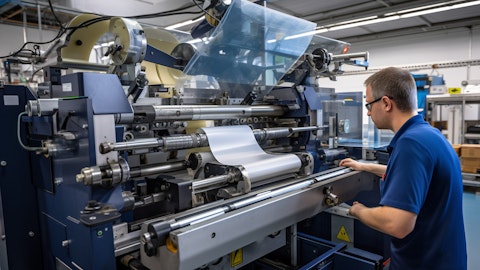Vista Energy, S.A.B. de C.V. (NYSE:VIST) Q3 2025 Earnings Call Transcript October 23, 2025
Operator: Good day, and thank you for standing by. Welcome to the Vista’s Third Quarter 2025 Earnings Webcast Conference Call. [Operator Instructions] Please be advised that today’s conference is being recorded. I would now like to hand the conference over to your speaker today, Alejandro Chernacov, Vista’s Strategic Planning and Investor Relations Officer. Please go ahead.
Alejandro Cherñacov: Thanks. Good morning, everyone. We are happy to welcome you to Vista’s Third Quarter of 2025 Results Conference Call. I’m here with Miguel Galuccio, Vista’s Chairman and CEO; Pablo Vera Pinto, Vista’s CFO; Juan Garoby, Vista’s CTO; and Matias Weissel, Vista’s COO. Before we begin, I would like to draw your attention to our cautionary statements on Slide 2. Please be advised that our remarks today, including the answers to your questions, may include forward-looking statements. These forward-looking statements are subject to risks and uncertainties that could cause actual results to be materially different from the expectations contemplated by these remarks. Our financial figures are stated in U.S. dollars and in accordance with International Financial Reporting Standards, IFRS.
However, during this conference call, we may discuss certain non-IFRS financial measures such as adjusted EBITDA and adjusted net income. Reconciliation of these measures to the closest IFRS measures can be found in the earnings release that we issued yesterday. So please check our website for further information. Our company is sociedad anónima bursátil de capital variable organized under the laws of Mexico, registered with the Bolsa Mexicana de Valores and the New York Stock Exchange. Our tickers are VISTA in the Bolsa Mexicana de Valores and VIST in the New York Stock Exchange. I will now turn the call over to Miguel.
Miguel Galuccio: Thanks, Ale. Good morning, and welcome to this earnings call. During the third quarter of 2025, we recorded a strong performance across key operational and financial metrics, especially on a sequential basis, driven by strong productivity in new well tie-ins in Bajada del Palo Oeste and La Amarga Chica. Total production was 127,000 BOEs per day, an increase of 74% year-over-year and 7% quarter-on-quarter. Oil production was 110,000 barrels per day, an interannual increase of 73% and 7% sequentially. Total revenues during the quarter were $706 million, 53% above the same quarter of last year and 16% above the previous quarter. Lifting cost was $4.4 per BOE, 6% below year-over-year. Capital expenditure was $351 million, driven by new well activity during the quarter.
Adjusted EBITDA was $472 million, an interannual increase of 52% and a sequential increase of 70%. Adjusted net income during the quarter was $155 million. Net income was $315 million, reflecting a nonrecurring gain of $288 million from the Petronas Argentina acquisition. Earnings per share was $3 and adjusted earnings per share was $1.5. Free cash flow in this quarter was almost neutral at minus $29 million, driven by higher adjusted EBITDA and a decrease in working capital. Finally, our net leverage ratio at quarter end was 1.5x on a pro forma basis. During Q3, we connected 24 wells, 11 in Bajada del Palo Oeste, 4 in Aguada Federal, and 9 corresponding to our 50% working interest in La Amarga Chica. We recorded solid productivity in the latest well tie-ins, which boosted Q3 production by 7% compared to the previous quarter.

Based on robust well performance, improvement in our oil realization prices and financial flexibility award by the $500 million term loan closed in July. We have decided to accelerate new well activity in Q4. We are now planning between 12 and 16 tie-ins in the next quarter, leading to between 70 and 74 connections for the year. We are seeing Q4 production about 130,000 BOEs per day, which leaves us on track to over deliver on production guidance for the year and the second semester. Total production in Q3 was 126,800 BOEs per day, an interannual increase of 74%. Oil production was 109,700 barrels per day, 73% above year-over-year. On a sequential basis, both oil and total production increased 7%, reflecting solid execution of our drilling campaign and robust well productivity during Q3, especially in Bajada del Palo Oeste and La Amarga Chica.
Bajada del Palo Oeste also drawn production in our operated block, which increased 50% compared to a year ago and 6% compared to the previous quarter. Gas production increased 87% on an interannual basis and 9% on a sequential basis. In Q3 2025, total revenues were $706 million, 53% above Q3 2024, driven by a strong increase in oil production, which more than offset lower oil prices. On a sequential basis, total revenues increased 16%, driven by 7% increase in total production and 4% higher oil prices. Oil exports increased 84% year-over-year to 6.3 million barrels for the quarter. Realized oil prices were $64.6 per barrel on average, down 5% on interannual basis and up 4% on a sequential basis, in both cases driven by international prices.
We captured higher Brent prices and lower discounts, which were around $1 per barrel during the quarter. During Q3, 100% of oil volumes were sold at export parity prices. In Q3, lifting cost was $4.4 per BOE, 6% lower compared to both the previous quarter and the same quarter of last year. This reflects our continuous focus on efficiency. Selling expenses per BOE were down 24% on an interannual basis, driven by the elimination of oil trucking services as of the start of the last quarter. Adjusted EBITDA during the quarter was $472 million, 52% higher on interannual basis, mainly driven by production growth, explained by the 15% in our operated production and the consolidation of 50% of La Amarga Chica. Compared to the previous quarter, adjusted EBITDA increased 17%, mainly driven by oil production growth.
Adjusted EBITDA margin was 67%, up 2 percentage points compared to the same quarter of last year as production growth and the elimination of oil trucking offset lower oil prices. Netback was $40.5 per BOE, up 8% on a sequential basis. During Q3 2025, cash flow from operating activities was $304 million, reflecting income tax payments of $179 million, partially offset by a decrease in working capital of $43 million. Cash flow used in investing activities was $333 million, reflecting accrued CapEx of $351 million partially offset by a decrease in CapEx-related working capital of $17 million. Free cash flow during the quarter was minus $29 million, reflecting higher adjusted EBITDA that drove cash from operations and a decrease of $59 million in working capital.
Cash flow from financing activities was $195 million, driven by proceeds from borrowings of $500 million, partially offset by the repayment of borrowings’ capital of $193 million and the repurchase of shares of $50 million. Finally, cash at period end was $320 million, our net leverage ratio on a pro forma basis reflecting the Petronas Argentina transaction stood at 1.5x adjusted EBITDA. To conclude this call and before we move to Q&A, I will make some closing remarks. During Q3, we recorded a robust well productivity in new well tie-ins, reflecting our high-quality asset base and peer-leading operating performance. This led to a material increase in adjusted EBITDA, both in a sequential and interannual basis, driven by production growth and continued focus on cost control.
Q3 production was well within guidance range for the second semester. Production growth in the fourth quarter on the back of solid productivity and more investment in our profitable ready-to-drill inventory leaves us on track to potentially over-deliver on our guidance. I remind you that we will be hosting our third Investor Day on November 12. During this virtual event, we will present an updated strategic plan, focusing on profitable growth, cost efficiency and cash generation. Before we move to Q&A, I would like to thank everyone at Vista for delivering a remarkable quarter. Operator, we can now move to Q&A.
Q&A Session
Follow Vista Oil & Gas S.a.b. De C.v. (NYSE:VIST)
Follow Vista Oil & Gas S.a.b. De C.v. (NYSE:VIST)
Receive real-time insider trading and news alerts
Operator: [Operator Instructions] Our first question comes from the line of Rodolfo Angele from JPMorgan.
Rodolfo De Angele: Thanks for the time to discuss the numbers presented yesterday. I’m sure we would like — looking forward to the investor event where you’re going to revise the strategic numbers. But for the time being, I think my question to you is on price realization. The numbers were pretty good. And compared to our expectations here, one of the positive surprises came from a realization of prices pretty solid versus Brent. So can you expand a little bit on what drove this? And what should we expect for the coming quarters? That’s it for me.
Miguel Galuccio: Rodolfo, thank you very much for your question. It’s a good one. There are basically 2 factors driving this good realization prices. With our spot export via the Atlantic, we have some flexibility regarding when we trigger the Brent price. This can potentially usually help us to capture some Brent price slightly above what you can see as a quarterly average. In Q3, the Brent averaged around [indiscernible], but the trigger Brent that we use to price the cargo was on average $1 higher. Also, the average discount of Brent was around $1 per barrel during Q3. So this is explained by 3 main factors. The first one is the high oil demand that we saw from West Coast U.S. due to seasonal factor. The other one was the very good demand that we have for Medanito.
And the last factor was the lower availability of other type of crude oil that usually compete with us like [indiscernible] crude. So that mainly explains why we have some good realization pricing during the Q3.
Operator: Our next question comes from the line of Leonardo Marcondes from Bank of America.
Leonardo Marcondes: So my question is regarding the drilling completion and tie-in of the wells since September’s figures beat the market expectations, right? So I would like to know if you could provide some color on the rationale of this significant increase in well tie-ins now, right? And also some color on what can we expect from this team for the remainder of the year? I mean, should you keep the rhythm on October, November, December?
Miguel Galuccio: Leonardo, thank you very much for the question. And I will explain and give you a bit of context on the rationale on the increase of well tie-ins. So I mean, as a recap, in April, we took on a bridge loan to finance the Petronas Argentina acquisition, as you know. In May, we successfully tapped to the international market and issued a bond of $500 million to take out the bridge loan. And also in July, a $500 million term loan to refinance all our short-term maturities, and that basically give us or regain full financial flexibility. We also consolidate the new assets. We saw very good productivity and production growth, even, I would say, better than our original expectation. And on the top of this, now there is less bearish consensus regarding the oil price.
So in summary, due to all these factors, we decide — we saw that we are aware in a position that we were more comfortable to basically accelerate CapEx. Regarding Q4, the short answer to your question is yes. You will see pretty much, I would say, 11 to 14 wells. And regarding ’26, you have to bear with me, I mean we have in a few weeks at our Investor Day in November 12, and I will probably wait to give you a full view of what we’re going to do in 2026 and onwards.
Operator: Our next question comes from the line of Bruno Amorim from Goldman Sachs.
Bruno Amorim: I have a follow-up question on the production outlook. It seems that you ended third quarter on a strong tone. So what does it mean for the fourth quarter, given you just mentioned you’re going to continue to drill and tie-in a significant number of wells into the fourth quarter. Can you elaborate on where do your current expectations stand versus your guidance for the remainder of the year?
Miguel Galuccio: Bruno. Yes, you can expect that the production for Q4 to be about the 130,000 barrels oil per day that we guide. As always, you will see the typical up and downs that we see month-over-month. As you know, the natural rhythm of how we tie-in the wells sometimes it’s not quarterly, but it’s changing month-by-month. But on average, Q4 will be similar to September. So this implies that we will likely be above guidance for the year. The guidance was between 112,000 and 114,000 barrels oil per day. And also [indiscernible] we will be about the guidance for the second semester, which was between 125,000 and 128,000 barrels oil per day. So yes, you can you can probably look at Q4 about 130,000.
Operator: Our next question comes from the line of Alejandro Demichelis from Jefferies.
Alejandro Anibal Demichelis: Congratulations on the quarter. Miguel, one quick question. Could you please indicate how you’re seeing the evolution of drilling and completion costs over the next few quarters? We have seen a bit of volatility on the FX. We have seen kind of inflation kind of going up a little bit. So just some kind of direction on how you see those costs go on, please?
Operator: [Operator Instructions]
Alejandro Anibal Demichelis: Congratulations on the quarter. Miguel, one quick question. Could you please indicate how you’re seeing the evolution of cost of drilling and completion costs over the next few quarters given the volatility on the FX, inflation and so on.
Miguel Galuccio: Yes, Ale here again. I mean we listened the first one, but thanks for the question. So we announced, I was saying in Q2 that our cost of the well was around $12.8 million. This is drilling and completion cost for well with a lateral length of approximately 2,800 meters and 47 stages. Today, we are slightly below this number and we are seeing very good results from the initiatives that also we announced last quarter that we will implement it. We are currently working on further initiatives on the same 2 verticals that were contracts and technology, so — which basically, we believe and we feel very strongly that will lead to further savings. So the idea is to comment and to give a lot of color and more color because we have very good news coming on that front on the Investor Day. So I hope you take that answer now, and we will give you more detail when we see you in the [ field ] on November 12.
Operator: Our next question comes from the line of Thiago Casqueiro from Morgan Stanley.
Thiago Casqueiro: Congratulations on the results. My question here is regarding La Amarga Chica. It’s been about 6 months since you acquired the stake in the assets. So looking back on this initial learning period, what would you say are the key challenges and opportunities you have identified in the assets so far?
Miguel Galuccio: Thiago, thanks for the question. Look, I mean, we have a very open and contractive relationship with YPF, I will say, at all levels. At my level, CEO and at the level of Matias in the field and everybody. You imagine they have been for many years, co-worker of us. So very good relationship, very good collaboration. We are collaborating in many fronts. First, I would say, sharing technical learnings. We regard ourselves as lead operator. We have learned a lot. YPF has a very extense experience in unconventional. So the sharing of practices has been very rich. Second, in opportunities on services and also in infrastructure, very collaborative and very open discussion also in those both fronts. The performance of the production and the cost efficiency this quarter was very good, I have to say, very good. So we are now focusing and discussing the 2026 [indiscernible] and the budget for that. But overall, it’s going very well.
Operator: Our next question comes from the line of [ Matteo Tosti ] from Citi.
Unknown Analyst: Congratulations on results as well. I was wondering while you may comment on M&A. I mean I remember last quarter, you touched on this, and we — you said maybe there was still appetite for M&A. And has this appetite continued? Is something that has maybe weighed down a bit? What can you comment on this?
Miguel Galuccio: Matteos, well, the short answer is the appetite is intact. So we have a proven track record, as I said before, creating value through M&A. So we are not only good operators, we have been very good M&A wise all the way up to here. And the best example of that probably the Petronas acquisition earlier this year. So that is part of our strategic approach as Vista. So given also that we are increasing our scale and our cash profile going forward, we will continue assessing opportunities. The only thing I will say that you have to take in consideration that we have a very high value in terms of value accretion and also in terms of strategic fit. But yes, the short answer is the appetite to M&A is intact for us, and we will continue looking to opportunities as they come.
Unknown Analyst: If I may add a quick follow-up. Are there any open processes today, maybe the opportunities to engage with other companies? Are there any open process, any assets available that you’re looking into? Or has the temperature cooled on that front, too?
Miguel Galuccio: No, I don’t think — I mean, as we said in a formal process, I don’t see any formal process that we are participating. We are having, yes, several discussions as always we have. As you know, the interest in Argentina have renewed a lot during the last few — during the last year. And also, we see new players coming into the country, I would say, exploring opportunities. So yes, we are maintaining discussion with all of them. But I will not say that we are participating in any formal process at the moment.
Operator: Our next question comes from the line of Tasso Vasconcellos from UBS.
Tasso Vasconcellos: Great. Miguel, maybe a follow-up question on the discussion on CapEx and production levels. If Vista were to only maintain current level of production is stable without much growth, what would be the level of CapEx required? And in this same sense here, what would be the maintenance CapEx to maintain production stable closer to 150,000 barrels a day. That’s my question.
Miguel Galuccio: Thank you, Tasso for the question. Yes, these are numbers that usually when we simulate our plans, we look into. I will say using 100,000 barrel per day of production as a reference, we will need around $700 million of CapEx to keep the production flat going forward. And that will imply probably between 50 and 55 wells. If we in [indiscernible] of 130,000 with 150,000 barrel per day, then I think that we should add one rounding the CapEx around $800 million and then the number of wells would be between 55 and 60 wells. So that will be around numbers. Of course, that could change also depend of the context now.
Operator: Our next question comes from the line of Michael Furrow from Pickering Energy Partners.
Michael Furrow: So there’s been a lot of attention on the upcoming midterm election. And for good reason, the outcome could have meaningful implications to the country. Now that said, the Vaca Muerta is an extremely valuable natural resource, and it seems to us that regardless of the outcome, this resource will continue to be developed. So I was hoping that you could maybe take some time to discuss your thoughts on the matter and if you see any outcomes from this weekend’s election that would have a material impact on Vista’s operations.
Miguel Galuccio: Thank you, Michael, for the question. It’s a recurring question and a good question. In short, the elections do not change our plan. We’ve been growing Vista from the scratch to where we are today, participating in 4 different administrations. And even before that, most of us came back to the country in 2012. And as we said, we were part of making Argentina a structural net exporter today and being part of the solution of the country. So the fact that we are holding an Investor Day 2 weeks after the elections is a full reflection of what we feel about the business. Our business model is solid, is dollarized, and we are increasing as we grow the amount of sales to the export market. So also, we said that we have secured the funding to continue growing, and we will discuss that in November 12.
And we don’t have any large financial debt maturity in the coming years. We also have secured the services, the rigs, the completions, the frac set with flexible contracts going forward. So no, Michael, I don’t think, I mean, the elections will affect multiples and other things or the perception of Argentina, but will not affect Vaca Muerta. It doesn’t affect our ability to continue growing and to execute our plan.
Michael Furrow: That’s great. I appreciate such a comprehensive answer.
Operator: Our next question comes from the line of George Gasztowtt from Latin Securities.
George Gasztowtt: Brent has remained pretty volatile again this quarter. And I was wondering what your EBITDA sensitivity to oil prices was now in 4Q.
Miguel Galuccio: Thanks, for the question. Yes, there is a sensitivity. Using 130,000 barrel oil per day production as a reference, you should think that for every dollar per barrel of changing in realized oil prices, the adjusted EBITDA in the fourth quarter will change approximately between USD 8 million and USD 9 million. That’s more or less will be the impact.
Operator: Our next question comes from the line of Juan Jose Munoz from BTG.
Juan Muñoz: Regarding La Amarga Chica, could you provide more color about the production of the 3Q? I understand that you finished on a strong note and also regarding the outlook that you have for La Amarga Chica in the last quarter of the year.
Miguel Galuccio: Thank you, Juan Jose, for the question. So in La Amarga Chica, let me do a bit of a recap of La Amarga Chica. In La Amarga Chica, we connect around 18 wells. And we have 50% of that work [indiscernible], so YPF connect 18. This well correspond to 4 parts, Pad 120, Pad 67, and these Pads, if I’m not mistaken, in the south triangle of the block and also the Pad 105 and the PAD 83 that are in the center of the block. All the 4 pads are producing above budget. The well performance of La Amarga Chica was good and the production was for Q2, 38.7 and they took it from 38.7 to 43.5 in Q3. So very good performance for Q3. And we are expecting — I cannot give you a number, but we are expecting a very strong performance also in Q4. So I hope that gives you a feeling of how we are looking at La Amarga Chica.
Operator: Our next question comes from the line of Francisco Cascarón from DON Capital.
Francisco Javier Cascarón: My question is what caused the decline in operated production during the first 2 months of the quarter? And if you are looking to accelerate that production going forward like we saw in September?
Miguel Galuccio: Thank you, Francisco. So yes, we saw a very good productivity in the wells that we connect during the quarter, specifically Bajada del Palo Oeste where we connect 11 wells that correspond to 3 different pads. Bajada del Palo 35 was connected in July, has 5 wells of around 3,400 meters in lateral length and 57 completion stages on average. Then we connect Bajada del Palo Oeste 36 that has 4 wells, lateral of 3,300 meters. On average, I think, around 50 stages. And then we — that was — the last one was connected in August. And then we connect Bajada del Palo Oeste 37 that has only 2 wells, 2,800 meters length and 48 stages on average that was connected in September. So what you’re seeing is the solid productivity of this 11 wells is the result of the boost production that you saw from Bajada del Palo Oeste that went from 56,400 barrels of oil per day in Q2 to 60,200 barrels oil per day in Q3.
So that are the pads that somehow result in the boosted production. You will see that also continuing in Q4.
Operator: Our next question comes from the line of Matías Cattaruzzi from Adcap Securities.
Matías Cattaruzzi: Miguel and Alejandro, my question goes on the regard of CapEx guidance. Given the current activity levels and the pulse of — the pace of well tie-ins, do you see a possibility of this year CapEx ending above the $1.2 billion guidance closer to $1.3 billion or over that number as recent trends in activity suggest?
Miguel Galuccio: Matias, yes, thanks for the question. Yes, I mean, we guide 59 wells, and we will be end up drilling between 70 and 74 wells. So you should add 11 to 15 wells to our original guidance. Of course, that will involve more CapEx or some additional CapEx. So you should think that [indiscernible] $1.2 billion. So you should think that we will end up between $1.2 billion and $1.3 billion for total CapEx for the year and Q4, a little over $300 million. So that is how you should look to the actual CapEx numbers.
Operator: Thank you. At this time, I would now like to turn the conference back over to Miguel Galuccio for closing remarks.
Miguel Galuccio: Well, thank you very much, everybody, for the participation. Of course, we are super happy with the quarter, a fantastic quarter for us. And I’m looking forward to see you all on November 12 in Argentina. Thank you very much, and have a good day.
Operator: This concludes today’s conference call. Thank you for participating. You may now disconnect.
Follow Vista Oil & Gas S.a.b. De C.v. (NYSE:VIST)
Follow Vista Oil & Gas S.a.b. De C.v. (NYSE:VIST)
Receive real-time insider trading and news alerts




